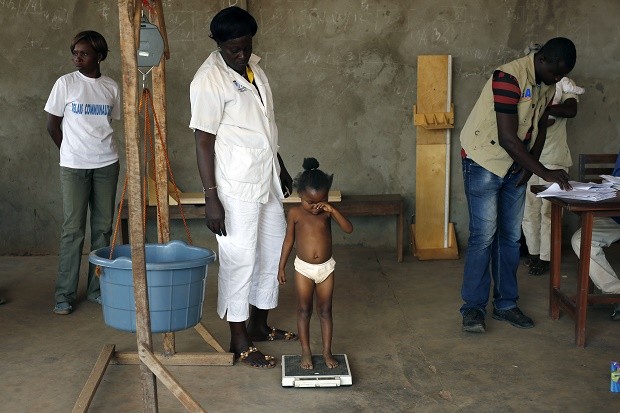
A child is weighed by nurses in Bangui, Central African Republic, Thursday Feb. 11, 2016. The UN World Food Program estimates that nearly half the country–2.5 million people–are facing hunger as more than two years of violence has severely disrupted the country’s agriculture and health care sectors.Two former prime ministers, Touadera and Anicet Georges Dologuele, are running neck-and-neck in the second round of presidential elections Sunday Feb. 14 to end years of violence pitting Muslims against Christians in the Central African Republic. AP
UNITED NATIONS — Thirty four countries — nearly 80 percent of them in Africa — don’t have enough food for their people because of conflicts, drought and flooding, according to a UN report released Wednesday.
The Food and Agriculture Organization’s Crop Prospects and Food Situation report said conflicts in Iraq, Syria, Yemen, Somalia, and the Central African Republic have taken a heavy toll on agricultural production, worsening the humanitarian crisis in those countries.
And the impact of these conflicts extends to neighboring countries that are hosting refugees, straining food resources in those countries, it said.
READ: In Mideast wars, hunger grips millions across the region
Congo is not only dealing with almost 100,000 refugees from Central African Republic but conflict in the east where an estimated 1.5 million people are displaced and flooding related to El Nino which has affected about half a million people, the report said.
FAO said drought associated with El Nino has “sharply reduced” 2016 crop production prospects in southern Africa. It said dry conditions linked to El Nino may also affect the planting of crops for the main growing season in areas of Central America and the Caribbean for the third consecutive year.
Dry conditions have also lowered expectations for harvests this year in Morocco and Algeria, the report said.
FAO also warned that drought and floods in North Korea in 2015 “sharply decreased” food crop production in the early and main growing seasons.
“With a reduced harvest in 2015, the food security situation is likely to deteriorate compared to the situation of previous years, when most households were already estimated to have borderline or poor food consumption rates,” the report said.
READ: More Filipinos hungry in 3rd quarter of 2015, survey says
The number of countries needing outside food assistance grew from 33 in December, after the addition of Swaziland where El Nino-associated drought conditions have sharply lowered 2016 cereal crop production prospects.
Other countries on the FAO list facing food shortages are Zimbabwe, Burkina Faso, Chad, Djibouti, Eritrea, Guinea, Liberia, Malawi, Mali, Mauritania, Niger, Sierra Leone, Burundi, Republic of Congo, Ethiopia, Kenya, Lesotho, Madagascar, Mozambique, South Sudan, Sudan, Swaziland, Uganda, Afghanistan, Myanmar and Nepal.
The report said elsewhere, the outlook for 2016 crops already in the ground, mostly winter grains in the northern hemisphere, is generally favorable and early forecasts indicate large wheat crops in most Asian countries.
FAO’s first forecast for wheat production in 2016 is 723 million tons. That’s 10 million tons below the record output in 2015.